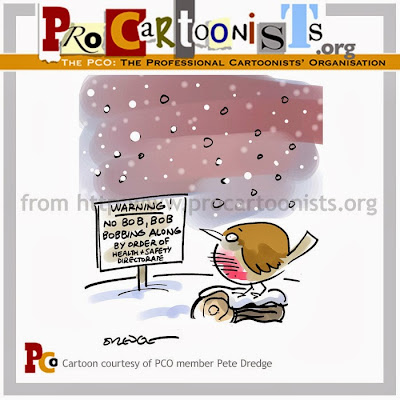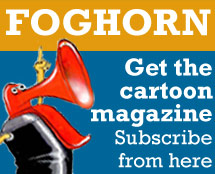Tayo Fatunla for the BBC World Service (Also, including Zapiro from South Africa).
Kipper Williams at the Guardian. The paper also offers a wide selection of art for the new year including Martin Rowson and Steve Bell.
Political cartoonist of the Year Morten Morland at the Times.
Pat Blower draws for The Daily Telegraph.
Matt Buck Hack cartoons for Channel 4.
And, Christian Adams of the Telegraph revisits the classic old and new year image.
The PCO: Great British cartoon talent
Subscribe to The Foghorn - our print cartoon magazine
Wednesday, December 31, 2008
Bloghorn's cartoon reviews of 2008 – and looking forward to 2009
Posted by Matt Buck at 11:29 AM 0 comments
Labels: Bloghorn, Christian Adams, Kipper Williams, Martin Rowson, Matt Buck (Hack), Morten Morland, Pat Blower, Professional Cartoonists Organisation, Steve Bell, Tayo Fatunla, Zapiro
2008 - a look back at St Just
PCOer Alex Noel-Watson reports on last year's version of one of the drawing things we have to look forward to in 2009:
Deep in the heart of the French countryside of the Limousin, in the department of Haute Vienne where characteristic tan-coloured cattle roam the lush meadows, nestles the village of Saint-Just-Le-Martel, near Limoges.
Saint-Just-Le-Martel could be described as the unofficial world capital of cartoons, thanks to the vision and energy of its mayor, Gérard Vandenbroucke, who 26 years ago started the annual Salon International de la Caricature, du Dessin de Presse et d'Humour.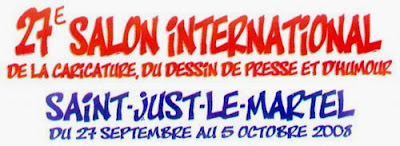 The Salon runs for ten days at the end of September and beginning of October, and approximately 200 cartoonists converge upon the village from all over the world, 100 for the first weekend and the remainder for the second. A small number of cartoonists stays for the whole ten days. All the cartoonists who attend the Salon are happily billeted with local families.
The Salon runs for ten days at the end of September and beginning of October, and approximately 200 cartoonists converge upon the village from all over the world, 100 for the first weekend and the remainder for the second. A small number of cartoonists stays for the whole ten days. All the cartoonists who attend the Salon are happily billeted with local families.
The Salon is the biggest exhibition of cartoons in Europe, probably the world. The vast main exhibition, displaying cartoons from every imaginable country, is supplemented throughout the Salon site and beyond (in Limoges) by numerous others.
This year these included the historic works of Daumier, a presentation revealing the astonishing versatility of the veteran French cartoonist, Roger Mofrey, exhibitions by Brito, Avoine, Tignons, Kerleroux, Cambon, Puig-Rosado and others; caricatures by Nalair, a large display of caricatures by Sterpone, Moine and others in the main area; the Cartooning for Peace exhibition, conceived by Plantu and already shown at the United Nations in New York and around the world, most recently in Jerusalem, Hollon, Bethlehem and Ramallah; cartoons from Québec, Cuba, Turkey, Portugal and Germany.
Saint-Just, however, is not resting on its laurels. For a long time Gérard Vandenbroucke has nursed the ambition to build a permanent world centre of cartoons. This dream is nearing fruition. Two years ago, the first symbolic bricks were laid, and Gérard told me that construction will begin at the end of this year.
"There will be 18 months of building works and the centre will be officially opened in 2010," he said.
The PCO: Great British cartoon talent
Subscribe to The Foghorn - our print cartoon magazine
Posted by Matt Buck at 11:02 AM 0 comments
Labels: Alex Noel-Watson, Bloghorn, Professional Cartoonists Organisation, St Just Cartoon festival
Friday, December 26, 2008
Bloghorn Artist of the Month - Denis Dowland
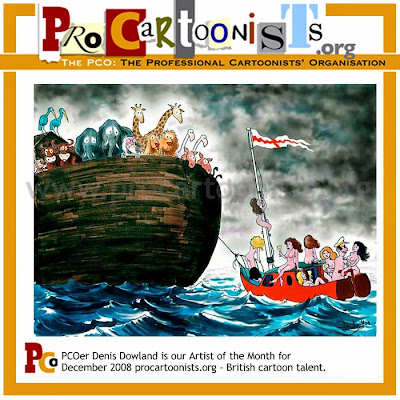
Reflecting on the future of cartooning in the digital age in our last entry for 2008, PCO Artist of the Month, Denis Dowland, writes:
Technological advances give with one hand and take with the other just like chancellors. I certainly do not miss the good old days of dragging heavy portfolios round studios, at or soon after lunch-time, to baffle brain-addled, red-braced juvenile yuppie editors, I'd better stop now, it's all coming back to me. I simply couldn't wait for the internet.
Now that video has virtually taken over the medium, however, the internet is swamped by infantile trash, taking us back to square one, if not further. This only requires an upgrading of our working methods, like the telephone once did. The threat I see as more insidious is the unstoppable drive toward the cretinisation of society as perhaps its only means of holding together, its naturally enthusiastic adoption by the mediocre and its resigned and guilty acceptance by those who do know better. Grumpy old git, moi? I love it.
The PCO: Great British cartoon talent
Subscribe to The Foghorn - our print cartoon magazine
Posted by Matt Buck at 10:13 AM 0 comments
Labels: Bloghorn, Denis Dowland, PCO Artist of the month, Professional Cartoonists Organisation
Tuesday, December 23, 2008
The spirit of Christmas
PCOer Clive Collins writes:
Some years ago I received a letter from the USA, from a lad of 14, who loved cartoons. He said he admired my cartoons (sic) and that he would dearly love to be a cartoonist, but that seemed an impossible dream, so might I oblige him with a small drawing, or signature, so he could compile a book of his heroes. I duly obliged and despatched a small signed self-caricature.
A couple of years later, and another letter arrived, from this same boy – who had remained miraculously 14 - with the same request. I ignored this one, and thought no more about it until, a while later, a package arrived containing 100 sheets of C5 blank paper, and a note stating that as I was obviously too busy, could I please pass round the sheets among my fellow cartoonists for them to do a drawing and/or signature for the book of cartoon heroes.
At this point I contacted cartoonist Mell Lazarus in the USA and asked him if he had ever heard of this boy. I could almost hear the acid laughter floating upon the water between us, when he replied that the ‘boy’ was well-known to American cartoonists, and in fact was a middle-aged lawyer who made quite a living, buying and selling original sketches and signatures at specialist auctions held all over the States. The Americans had given this guy the bum’s rush, and he guessed that now it was our turn. There was a son but he had grown up.
The PCO: Great British cartoon talent
Subscribe to The Foghorn - our print cartoon magazine
Posted by Matt Buck at 9:28 AM 0 comments
Labels: Bloghorn, cartoon collectors, Christmas, Clive Collins, Professional Cartoonists Organisation
Monday, December 22, 2008
Santa Claus and the cartoonists
 PCOer Chris Madden writes:
PCOer Chris Madden writes:
The exact origins of Father Christmas (as opposed to Santa Claus) are lost in time: he was probably a pagan personification of midwinter, who put in an appearance around the solstice on December 21st. Indeed, he may well have been one and the same person as the old bearded man with the scythe and hour-glass, Father Time, who turns up at New Year, a week or so after Christmas is over (and once he’s slept off the sherry and mince pies). Father Christmas was a central character in Britain’s seasonal festivities long before Santa Claus joined in the celebrations. Santa didn’t really participate in the fun until the nineteenth century. However, once Santa put in an appearance he soon pushed the original Father Christmas into the background. Why? Because Santa was an American. Or, to be more precise, an American descendant of Turkish ancestry.
The original Santa Claus was Nicholas, a 4th century bishop of Myra in Turkey, who reputedly handed out gifts to children. (Very suspicious, if he were around nowadays there’d be a heavy police file and, possibly, an electronic tag around his ankle.) The bishop remained relatively obscure for fifteen hundred years or more until his star suddenly rose in the nineteenth century.
St Nicholas entered popular culture in the United States when, in 1809, the novelist Washington Irving (who wrote Rip Van Winkle) penned a satire on the Dutch culture of New York (a city that had a strong Dutch element in its history – so much so that it was originally called New Amsterdam). In his satire he referred to Saint Nicholas by his Dutch name of Santa Claus and portrayed him somewhat like an elfin Dutch burgher with a clay pipe.
A few years later, 1822, Dr. Clement Clarke Moore, a professor at a theology college in New York and the son of the Bishop of New York and his heiress wife (the family were so rich that the college at which Moore taught was built on their own estate), read Irving’s book and published a poem based on the Santa Claus character: “Twas the night before Christmas, when all through the house, not a creature was stirring, not even a mouse.” The poem became a great hit: you may be familiar with it yourself (or at least with its opening lines). It was in this poem that Santa first acquired his reindeer. Before this he had to make do, somewhat bizarrely, with an eight-legged flying horse.
At this point the Santa industry went stratospheric. With the poem as inspiration, the cartoonist Thomas Nast started to draw the first of what would eventually be more than two thousand illustrations for Harper’s Weekly magazine depicting Santa. Nast's early depictions of Santa showed a rotund gent of quite serious demeanor, becoming more jovial over the passing years. This Santa was closer to Washington Irving’s version than the usual stern bishop of previous tradition. Nast also gave Santa his headquarters at the North Pole and his army of toiling elves.
Here's Nast's first depiction of Santa, from Harper's Weekly of 3rd January 1863 (which also included another, much smaller illustration of Santa by Nast).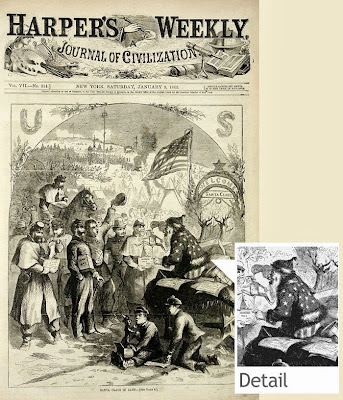
Judging by this illustration you may think that Santa's wearing a rather festive outfit, festooned with Christmas stars - however, if you look at the original drawing you'll see that he's sitting beneath a Union flag. The suit - with its starry jacket and striped trousers - represents this flag. If the illustration had been in colour the jacket would have been blue (I bet you assumed that it was red), reflecting the colour of the ground behind the stars on the flag, while the trousers would be red and white stripes. Nast was essentially a political cartoonist - and in political cartoons wrapping a character in a flag to signify their allegiance is quite common.
At the time that Nast created the illustration the American civil war was in progress. Nast was on the Unionist side. The puppet in Santa's hand bears an uncanny resemblance to Jefferson Davis, the president of the Confederate states of America whom the Unionists, or Federal states, were fighting.
It was essentially Nast’s imagination that gave us the Santa that we know today – except, that is, for his red coat with white trim. Santa reputedly wears a red and white outfit because they are the corporate colours of the Coca Cola Corporation, who enlisted Santa to promote their fizzy drink in the 1930s. The Coke ads were created by an American commercial artist of Swedish ancestry, Haddon Sundblom, who modelled his Santa on his friend Lou Prentice, chosen for his cheerfully rotund features.
So it is that Santa Claus doesn’t actually come from the North Pole but from New York city, and he doesn’t date from the birth of Christianity two thousand years ago but from the early days of capitalism in the mid-nineteenth century.
The PCO: Great British cartoon talent
Subscribe to The Foghorn - our print cartoon magazine
Posted by Matt Buck at 9:01 AM 0 comments
Labels: Chris Madden, Dr Clement Clarke Moore, Father Christmas, Haddon Sundblom, Professional Cartoonists Organisation, Saint Nicholas, Santa Claus, Thomas Nast
Friday, December 19, 2008
Christmas Cartoon Pick of the Week

The festive season is upon us, so this week Bloghorn has a bulging sack full of Christmas themed cartoons...
One: Simon Bond in Private Eye: 'City Christmas Tree 2008'
Two: From Tony Holland in the Spectator, the credit crunch hits the Twelve Days of Christmas
Three: Christmas tree dressing at Number 10 for Peter Brookes in the Times
Four: Martin Rowson in Tribune shows the Three Wise Men investing poorly
Five: The Guardian asked artists, singers and comedians to "reinvent" Santa Claus, including Gerald Scarfe
Six: Royston Robertson in Reader's Digest on good health at Christmas
Seven: Patrick Blower has a Livedraw animation on media-savvy shepherds
Eight: Will "Wilbur" Dawbarn in Reader's Digest on the season of goodwill in a bad neighbourhood
Nine: Matt "Hack" Buck in Tribune on the non-jingling tills
The PCO: Great British cartoon talent
Subscribe to The Foghorn - our print cartoon magazine
Posted by Alex Hughes at 11:00 AM 0 comments
Labels: Cartoon Pick of the Week, Christmas, Martin Rowson, Peter Brookes, Private Eye, The Spectator, The Times, Tribune
Bloghorn Artist of the Month - Denis Dowland
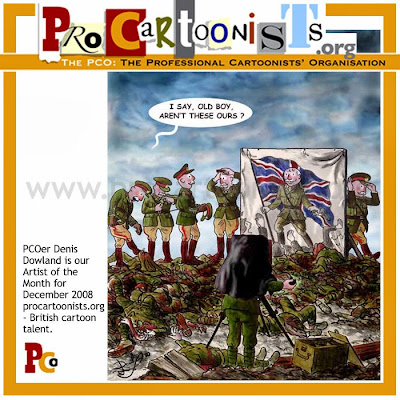
PCO Artist of the Month Denis Dowland, tells Bloghorn about some of his cartoon influences: "A good gag's a good gag so I am not so particular about graphic styles. I think the great majority of cartoonists, and I don't even mind being counted as one of them, come up with at most a handful of works that will stand the test of (short to medium) time.
"Bill Tidy, McLachlan and lots of people whose names I cannot even recall have done stuff I wished I had done, never mind Cruikshank. Larson, ubiquitous as he is, comes up with real beauties in my view, and I'm slowly working my way around claiming authorship of one or two of that chap Stott's scribbles as well. I have just seen Scarfe's exhibition and some of his caricature is jaw-dropping. Caricature is a discipline I have never attempted, I couldn't tell you why."
His top tip for aspiring cartoonists is: "Get a job. I am not a good role model for any aspiring artiste (sic). Some young people want to become cartoonists for the same reasons they'd want to be pop stars. It's a pose one can strike without bothering to learn a craft. This is of course a reflection of my own middle-age views and experience. I would try to inspire young people to embrace neurology, astrophysics or history or any scholarly pursuit instead. Boring old prat, I know. I love it."
The PCO: Great British cartoon talent
Subscribe to The Foghorn - our print cartoon magazine
Wednesday, December 17, 2008
The Big Draw banners for sale
Back in November we blogged about the PCO's team for Transports of Delight – a cartoon banner competition held at St Pancras rail station in London as part of the The Big Draw.
Well, now you can own a piece of cartooning history as the four banners in the competition (from The Guardian, The Independent, Private Eye and the PCO) are being auctioned off on eBay, with all proceeds going to the Campaign for Drawing, a charity whose purpose is to promote drawing as a tool to support learning, and cultural and social engagement for all ages and abilities. The winning banner from The Independent (Dave Brown, Tim Sanders, Chris Burke and Bloghorn Editor Matt Buck)
The winning banner from The Independent (Dave Brown, Tim Sanders, Chris Burke and Bloghorn Editor Matt Buck) The Guardian (Steve Bell, Martin Rowson, Tim Pond and PCO Chair leg Andy Davey)
The Guardian (Steve Bell, Martin Rowson, Tim Pond and PCO Chair leg Andy Davey) Private Eye (Andrew Birch, Richard Jolley, Simon Pearsall and Ken Pyne)
Private Eye (Andrew Birch, Richard Jolley, Simon Pearsall and Ken Pyne) and last but not least the Professional Cartoonists' Organisation (Pete Dredge, Robert Duncan, Kipper Williams and Bloghorn writer Royston Robertson)
and last but not least the Professional Cartoonists' Organisation (Pete Dredge, Robert Duncan, Kipper Williams and Bloghorn writer Royston Robertson)
Hurry though, if you do want to make a bid, as the auctions end on the evening of Monday 22nd December!
The PCO: Great British cartoon talent
Subscribe to The Foghorn - our print cartoon magazine
Posted by Alex Hughes at 11:54 AM 0 comments
Labels: Bloghorn, Private Eye, Professional Cartoonists Organisation, The Big Draw, The Campaign for Drawing, The Guardian, The Independent, Transports of Delight
Tuesday, December 16, 2008
Fast footwork

Spotted by PCOer Morten Morland and with a handy translation.
The PCO: Great British cartoon talent
Subscribe to The Foghorn - our print cartoon magazine
Posted by Matt Buck at 11:43 AM 0 comments
Labels: Bloghorn, digital cartoon, digital image-making, Professional Cartoonists Organisation
Monday, December 15, 2008
John Jensen recalls some beaut, bonzer comics
Following on from his look at the weird and wonderful work of Fletcher Hanks, PCOer John Jensen takes another trip back to the comic books of the 1930s and 1940s with the focus on his native Australia
"The Case of the Haunted Piecrust", "Wocko the Beaut", "Supa-Dupa Man", "Speed Umplestoop" and "Tripalong Hoppity" – all of these and many more funnies fell out of the wonderfully zany mind of cartoonist Emile Mercier.
A panel from "Wocko the Beaut", courtesy of Lambiek.net
Mercier was born in New Caledonia in 1901. Twenty years later, in Australia, he began his career as a freelance cartoonist. During the Second World War, the bulk of his work, the comics, appeared in an array of Frank Johnson Publications. Johnson encouraged Australian talents and his publications developed a character and liveliness which set them apart – sometimes for the better, sometimes not – from the many US imports which which were dumped in Australia, usually as ships' ballast, during the war.
Due to wartime paper restrictions, Johnson was forced to reduce the size of some offerings: Star Pocket Comics ran for at least 14 issues, successful in spite of some issues being printed on brown wrapping paper. The same paper shortage brought forth a decree that there would be no new regular runs of comic books.
Johnson resorted to cunning to deal with the situation. His regular characters continued to appear each month but each issue bore a new title: King Comics, Amazing Comics, Gem Comics, Slick Comics, Bonzer Comics, Flash Comics and more. When imagination failed, the word "new" was tacked to an old title and the process began over again. Mercier's work appeared in most of these issues.
Mercier was a people watcher but the people he watched, ordinary everyday Australians, were transformed into creatures of his eccentric universe. Occasionally in the background of a cartoon someone would be walking around with springs on his or her feet, or on stilts or jumping around on pogo sticks. His characters' feet quite often sagged at a ninety-degree angle half way along the sole of the foot. Dogs, cats and boozy types abounded. Mercier's cast list was very Australian.
I met Mercier just after the war, and I asked him for his definition of a good cartoon. "A good cartoon, sonny, is one that is accepted, published and paid for," he said. You might argue with this definition but for me it was heart-lightening.
A few months after our meeting I took my first comic strip, "Mary Mixup, Female Spy Terrific" (by Jon J) to Frank Johnson Publications where, to my amazement it was accepted and published. My mother, who hated comics, wouldn't have them in the house. When I took home my copy of Gem Comics No.27 with "Mary Mixup" within, Mum took it, tore it and threw it away.
John Jensen's "Chester Nutte" was published in Gem Comics, circa 1947
In spite of this, other titles followed, such as "Chester Nutte", a time traveller, above, and "Snooper McDroople, Ace Newspaper Reporter". Mercier's drawing never influenced me but a little of his humour rubbed off. The strips improved a bit over the twelve months I worked on them and there were strips for other comics publishers too, but "Mary Mixup" was an abomination.
Frank Johnson wanted to withhold payment because the drawings were so bad. I remembered what Mercier had told me, and squeaked: "If the drawings are good enough to publish, they are good enough to be paid for." A voice from a neighbouring office said, "Y'can't argue with that, Frank."
Johnson paid up – eventually. I think he was so traumatised by my demand that he continued to use my work, and pay for it ... eventually.
Bloghorn says click J for Jensen.
The PCO: Great British cartoon talent
Subscribe to The Foghorn - our print cartoon magazine
Posted by Royston Robertson at 9:00 AM 0 comments
Labels: Australia, children's comics, comics, Emile Mercier, Frank Johnson Comics, John Jensen, Wocko the Beaut
Sunday, December 14, 2008
Goodbye big print (and cheerio President Bush)

PCOer Andy Davey writes:
One thing that all cartoonists are very aware of is that the face of publishing has changed. Much of it has been a little scary for established old-media cartoonists, but one of the undoubted benefits of the new trends has been on-demand printing.
While there’s still a need for hard copy (books for fireside, on train, lining impressive bookshelves, in tent up mountain etc), self-publishing sites provide the bridge between the mature and the new by converting digital files into comforting, heart-warming, cuddly books to be held and cherished.
An example, I hear you ask? Oh, if you insist. You could, for example, check out a short cartoon booklet called Bush Combat by UK cartoonist Andy Davey (see it here). This was published, like fellow PCO cartoonist Ger Whyman’s book on the self-publishing site, Lulu.
The book covers the pugilistic adventures of the boy George Dubya, from early spats with the UN, through the horrors of Iraq, right up to his search for a legacy in the Middle East. The time seemed right; it is meant as a last post to his disastrous tenure in the White house. The editorial cartoons all have brief explanations for those with medium-term memory loss; they were mostly published in The Guardian, The Times and The Independent over the last six years. Some are previously unpublished. It’s long on pictures and short on text, so even Dubya himself could order one and understand it … possibly.
The PCO: Great British cartoon talent
Subscribe to The Foghorn - our print cartoon magazine
Posted by Matt Buck at 10:55 PM 0 comments
Labels: Andy Davey, Bloghorn, digital cartoon, digital image-making, lulu.com, Professional Cartoonists Organisation, self-publishing, The Guardian, The Independent, The Times
Friday, December 12, 2008
Cartoon Pick of the Week

Bloghorn spotted this great work this week ...
One: Nicholas Garland in the Daily Telegraph on Robert Mugabe
Two: Matt Buck (aka Hack) at Channel 4 News on the ailing Pound
Two: Patrick Blower at Livedraw (note: video file) on Brown saving the world
The PCO: Great British cartoon talent
Subscribe to The Foghorn - our print cartoon magazine
Posted by Royston Robertson at 12:29 PM 0 comments
Labels: Channel 4 News, Daily Telegraph, LiveDraw, Matt Buck (Hack), Nicholas Garland, Patrick Blower
Bloghorn Artist of the Month - Denis Dowland
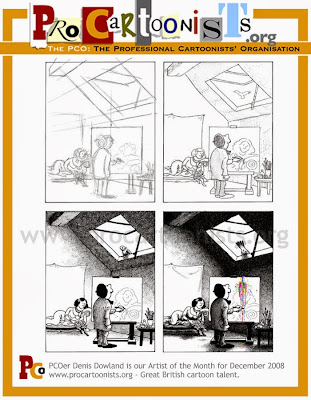
PCO Artist of the Month, Denis Dowland, reveals to Bloghorn how he goes about producing his cartoons ...
"I have had to learn to resist the Big Creative Rush, especially after a grand meal or closing time, when everything comes out so clear and sharp and you can do, of course, no wrong.There will be more work from Denis next Friday.
"I have to let most ideas stew for some considerable time, we're talking months here, mostly, before I commit them to paper, or nowadays the computer, lest I look at a page in total bafflement as to what on earth I may have had in mind the night before. I think something similar happens to Gary Larson on occasion.
"Once the idea is fixed it's like painting by numbers. I love having just finished a picture but doing it is a grind; a common enough malaise."
The PCO: Great British cartoon talent
Subscribe to The Foghorn - our print cartoon magazine
Posted by Matt Buck at 8:39 AM 0 comments
Labels: Bloghorn, Denis Dowland, PCO Artist of the month, Professional Cartoonists Organisation
Thursday, December 11, 2008
PCOer Morten Morland wins political cartoonist of the year

PCOer Morten Morland won the Political Cartoon Society's cartoonist of the year yesterday. Bloghorn is publishing one of Morten's Post-it note caricatures of Gordon Brown above.
Bloghorn's alter ego, and the current chair leg of the PCO, Andy Davey said:
It's great that Morten has won this. He's one of the best cartoonists working in the UK. The judges commended his immediately recognisable style and use of unusual perspective - I'd second that. And he does it all with only one real outing in the UK media per week - watch Mondays in The Times newspaper.Steve Bell, of The Guardian, won best single image of the Year, for something like this and Peter Shrank of The Independent on Sunday was runner-up.
Morten has a word at his blog.
Christian Adams has a report here too.
The PCO: Great British cartoon talent
Subscribe to The Foghorn - our print cartoon magazine
Posted by Matt Buck at 8:17 AM 0 comments
Labels: Morland, Morten Morland, Peter Schrank, Political Cartoon Gallery, Professional Cartoonists Organisation, Steve BellThe Times, The Times
Wednesday, December 10, 2008
Cartoonist takes issue with cartoon awards

Everyone likes an online row, and cartoonist Rod McKie has provoked one on his blog with a blast at the recent Cartoon Art Trust Awards. (We blogged it here.)
Rod is an established professional cartoonist, well known for his forthright opinions. In this article he dismisses the entire genre of caricature (“It’s a fairly tired old medium now, isn’t it?”) and all political cartoonists (“They are all cowards who row-in with the ideology of the press barons they work for”). His particular beef against the CAT awards is that they are an “insular, parochial, London-based affair”, and he doesn’t appear to value many of those who won awards. Cartoonists have pitched in on his blog – including one of the award recipients – some agreeing and others disagreeing.
Bloghorn takes the view that anyone who sets up an award and is prepared to pay for the preparations, gets to choose how to judge it. You may not agree with their choices, but isn’t this always the way with awards ceremonies? Look at the grumblings that surround the Oscars every year.
But we are prepared to defend the Cartoon Museum itself, which is run by the Cartoon Art Trust. The museum, which receives no public funding, is among the most popular small museums in the country. There are some visitor reviews available here. Rod says the CAT has "never appeared on my radar" and adds that he knows nothing about the museum, as if that justifies his dislike.
Cartoon Museum workshops cover cartooning in all its forms. Pic: Cartoon Museum
The London museum may seem irrelevant to a cartoonist based in Scotland, but if he did make a trip, he would find that they do some great work, and it’s not all about joke and political cartoons or caricature. Look at the work that cartoonist Steve Marchant does there, running endless workshops and creative classes for young people. These cover comics, graphic novels and manga … the works.
We also take issue with the notion that cartoons that appear in British newspapers and magazines are somehow “parochial”. Rod seems to be of the view that in a globalised economy all cartoons should appeal to the whole world. We argue cartoons should reflect the real lives and experiences of people and any attempt to homogenise them for a world audience would be bad for cartooning as a whole.
Discuss. All comments welcome. Comment moderation is turned on.
Royston Robertson and Matt Buck
Updated at 3pm 9th December 2008:
The Cartoon Museum has kindly sent details of its visitor numbers since Britain's first dedicated museum to the art of the cartoon opened in February 2006. Curator Anita O'Brien reports that from the time the museum opened in February 2006 until the end of 2006 it had 17,653 visitors. During 2007 this rose to 24,110 and to date in 2008, 27,410.
The PCO: Great British cartoon talent
Subscribe to The Foghorn - our print cartoon magazine
Posted by Royston Robertson at 1:27 PM 1 comments
Labels: Bloghorn, Cartoon Museum, cartoon awards, Cartoon workshops, Professional Cartoonists Organisation, Rod McKie
Tuesday, December 9, 2008
A cartoon obituary and a cartoon award
An obituary for Oliver Postgate creator of many children's television animations and an award for Posy Simmonds for her drawn interpretations of novels. Via
Updated: The Guardian has a fine YouTube tribute to Oliver Postgate's work here. A particular mention for this clip...
The PCO: Great British cartoon talent
Subscribe to The Foghorn - our print cartoon magazine
Posted by Matt Buck at 9:45 AM 0 comments
Labels: cartoon awards, cartoon obituaries, Oliver Postgate, Posy Simmonds
Monday, December 8, 2008
Heart-warming Christmas tale

PCOer Adrian Teal writes:
I had a phone call from the news desk of my local paper recently asking if I’d mind doing a last-minute cartoon about our gaffe-prone town council.
The council had ditched the idea of suspending Christmas decorations across the town’s main shopping street, because Health and Safety were worried about them plummeting onto the heads of innocent shoppers. As an alternative, they decided to import some hollow, cone-shaped, fake trees which cost £33,000.
When the lorry carrying the new trees arrived at the council depot, two Iraqi, and two Iranian illegal immigrants jumped out of the back. They were rounded up by the cops, and handed over to the UK Border Agency.
Adrian reports the trees themselves were "rubbish". Bloghorn thinks none of us are six anymore.
The PCO: Great British cartoon talent
Subscribe to The Foghorn - our print cartoon magazine
Posted by Matt Buck at 10:13 AM 0 comments
Labels: Adrian Teal, Christmas, Professional Cartoonists Organisation
Friday, December 5, 2008
Cartoon Pick of the Week

Bloghorn spotted this great work this week...
One: Stephen Hutchinson (aka Bernie) in Private Eye on child protection officers
Two: Gerald Scarfe in the Sunday Times on India
Three: A spot of blowing our own Foghorn ... Noel Ford on the cover of the new Christmas issue of the PCO's cartoon magazine. (Below – click image to enlarge). Subscribe to The Foghorn here The PCO: Great British cartoon talent
The PCO: Great British cartoon talent
Posted by Royston Robertson at 12:38 PM 0 comments
Labels: Bernie, Foghorn, Foghorn cartoon magazine, Gerald Scarfe, Noel Ford, Private Eye, Professional Cartoonists Organisation, Stephen Hutchinson, Sunday Times
PCO Artist of the Month - Denis Dowland

The PCO Artist of the Month for December 2008 is Denis Dowland.
Denis's output ranges from traditional gags, or, joke cartoons to "conceptual absurdism" (his description).
He tells Bloghorn that from a young age that he was always drawing;
"As a child I was perceived as a gifted artist, due mostly, I imagine, to my favouring pen and ink which perhaps isn't the most instinctive medium for a young child. My work covered surrealism and assorted weirdness until the late 80s when a sadly short-lived mini boom in new-wave satire, for want of a better term, and an awakening to the possibilities of the graphic novel inspired me to produce a number of faintly surreal and twisted short stories for the more forward-looking magazines of the day.There will be more from our interview with Denis next Friday.
"It did not turn out to be a living proposition, however, so I started producing gag cartoons, mostly unpublishable due to size and/or subject, for individual buyers, until the frustrations of word of mouth existence made me call it a day. We had to wait 10 years for the digital revolution to re-open the doors and persuade me to have another go."
The PCO: Great British cartoon talent
Subscribe to The Foghorn - our print cartoon magazine
Posted by Matt Buck at 8:54 AM 0 comments
Labels: Bloghorn, Denis Dowland, PCO Artist of the month, Professional Cartoonists Organisation
Thursday, December 4, 2008
The far side of the world of cartoons
King Features syndicated strip cartoon artist (and ex-pat Brit) Alex Hallatt has a write-up of the state of the Australian cartoon world. You can find her report from the recent Stanley Awards here.
The PCO: Great British cartoon talent
Posted by Matt Buck at 11:09 AM 1 comments
Labels: Alex Hallatt, Arctic Circle cartoons, The Australian Cartoonists’ Association, The Stanley Awards
Wednesday, December 3, 2008
Cartoonist has a go at cartoonists
Cartoonist Stephan Pastis has used his newspaper comic strip Pearls Before Swine to take a very funny swipe at cartoonists who peddle what he sees as hackneyed and dated gags about subjects such as golf, henpecked husbands and "hot secretaries". Bloghorn says, feel free to voice your objections to either side of the argument in comments, below.
You can see the strip here. Thanks to Mike Lynch.
The PCO: Great British cartoon talent
Posted by Royston Robertson at 11:18 AM 2 comments
Labels: cartoon clichés, cartoonists, comic strips, Mike Lynch, newspaper strips, Pearls Before Swine, Professional Cartoonists Organisation, Stephan Pastis
Monday, December 1, 2008
What the digital cartoonist does
US caricaturist Tom Richmond demonstrates on his blog how he digitally colours his illustrations for Mad magazine:
The PCO: Great British cartoon talent
Posted by Matt Buck at 10:04 AM 0 comments
Labels: Bloghorn, digital cartoon, Mad magazine, Professional Cartoonists Organisation, Tom Richmond

